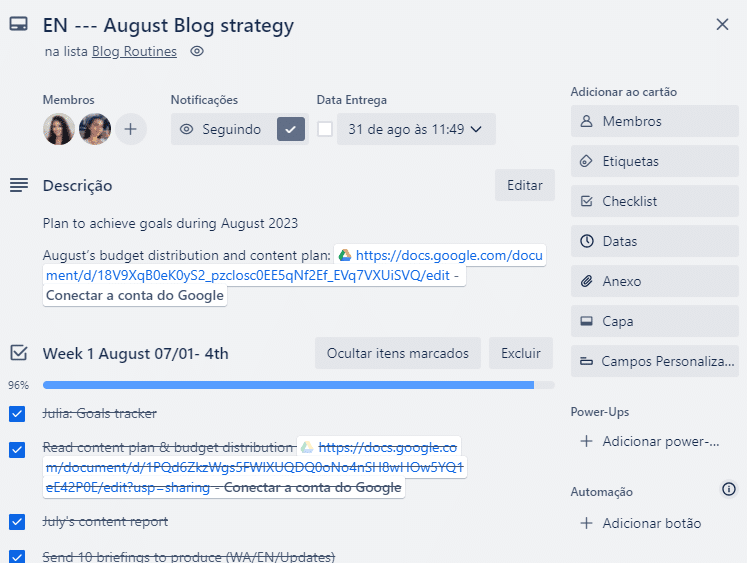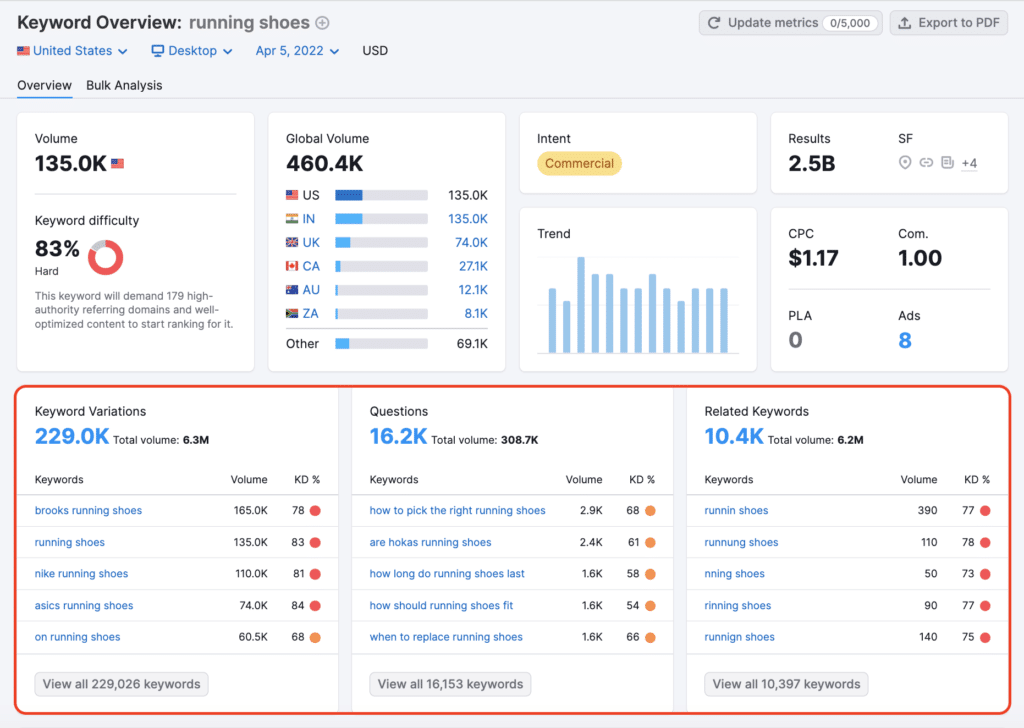Content marketing can feel a lot like digging for buried treasure. You need to have a map in hand or you’re going to end up missing the mark more often than not.
So, to truly achieve your goals, you need to map out your path to success by creating an effective content marketing plan. A well-built plan will lead the way in creating engaging content, distributing it to the right channels, and measuring its success.
Ready to start building your plan? You’ll need a map for that, too, and that’s where this quick guide comes in. Just follow the top nine steps to creating a content marketing plan to get started.
- What Is Included in a Content Marketing Plan?
- The Role of a Content Marketing Planner
- 9 Steps to Creating a Content Marketing Plan
- BONUS: Invest in SEO to Enhance Content Visibility and Organic Growth
- How to Scale Your Marketing Plan
How Do You Write a Content Marketing Plan?
Outline your goals
You should start writing a content marketing plan by documenting your marketing goals.
You must state in clear terms what the marketing strategy is aimed at achieving. You should also write down the timeline for implementation and the expected results.
This will guide you when the marketing campaign starts.
Perform an audit
When you intend to write a good content marketing plan, it is advised that you take stock of previous marketing plans. You need to analyze what your brand has done before and how effective it was.
Through this exercise, you can incorporate what has been working and avoid repeating past mistakes.
Draft out your strategy
The goal of writing a content marketing plan is to develop a marketing strategy.
Your marketing strategy should contain detailed steps of everything you and your team are going to do throughout the campaign.
It should also include guidelines on the kind of content to be released as well as the tone with which it should be conveyed.
Assign roles
Everybody’s job is nobody’s job. To achieve a successful marketing campaign, you need to assign specific roles to the various members of your team.
You must document the specific tasks your team members are to perform. It enables you to keep track of implementation and know who is accountable for the various tasks during the campaign.

What Is Included in a Content Marketing Plan?
In a content marketing plan, you should expect to see the following:
Mission statement
The mission statement clearly states the goals of the marketing campaign. It contains the scope of activities for the campaign as well as the timeline for completing the campaign.
Marketing metrics
In a content marketing plan, there should be a representation of customer satisfaction data.
There should also be data on the target audience’s demographics. This would help you understand what the customer wants and tailor your content to your audience.
Data on your competitors’ marketing campaigns can also be included.
In addition to these, the agreed-upon key performance indicators (KPIs) for the campaign should be clearly stated. These KPIs are the metrics you should use to measure the effectiveness of your media campaign.
Content marketing strategy
A content marketing plan would be incomplete without a content marketing strategy. The content marketing strategy contains step-by-step details of how the campaign should go.
There are details on the type of content to be used, the campaign calendar, and the roles assigned to each member of the team.
This serves as a guide for your marketing team throughout the campaign.
The Role of a Content Marketing Planner
The content marketing planner is the person in charge of coming up with the content marketing plan for a brand. The roles of a content marketing planner include:
Content responsibility
The content marketing planner is responsible for the content used for the marketing campaign. The content used is the primary determinant of the success or failure of the campaign.
They have to make sure that the content suits the culture of the brand and addresses the pain points of the target audience.
Team and project management
The success of a brand’s content marketing plan can be found in its implementation. For this to happen, the project needs to be managed effectively.
The content marketing planner is in charge of both the team and the marketing project.
They need to have strong leadership skills and must be able to promote team collaboration.
A content marketing planner must also closely monitor the project and ensure that the marketing campaign remains within its scope and timeline.
They also need to regularly monitor the KPIs to determine the effectiveness of the content marketing plan.
9 Steps to Creating a Content Marketing Plan
A great content marketing strategy helps you create the right content and deliver it where your customers spend their time online.
So, it’s well worth taking the time to build a winning plan for your brand. Here’s how to get it done.
1. Know your target audience well
Your content must speak to the needs, wants, and dreams of your customers to make the greatest impact. To accomplish that, you have to know your target audience and know them well.
There are two ways to get to know your audience: buyer personas and jobs to be done.
With buyer personas, you create a picture of who your customers are by defining their:
- Demographics
- Likes and dislikes
- Shopping habits
- Key challenges
- Motivations
Jobs to be done gives additional customer insights by simply focusing on their reason for choosing to interact with your brand.
2. Do benchmarking and competitor analysis
Before you can move forward in creating a plan, you need to know where you – and your competitors – currently stand.
With that info, you can decide how to do things better than ever before.
Start by reviewing your content performance. Look at how well your existing content resonates with your target audience, and then reflect on how you could do better. Are you ranking for any industry keywords? Could you rank higher?
After that, turn your attention to your top three competitors’ content marketing efforts.
For each one, ask:
- How in-depth does their content go on each topic?
- What keywords are they consistently ranking high for?
- Is their content generating shares on social media?
Then, simply use all that info to help shape your content marketing plan.
3. Research industry keywords
If you haven’t completed any keyword research for your brand, it’s definitely time to do so.
Keywords serve as beacons of light, guiding customers your way with every relevant search.
Your content needs to have relevant keywords in all the right places to aid in that journey.
In fact, every piece of content should have a main keyword all its own, plus semantic keywords supporting it.
Although that might sound overwhelming, online tools, like SpyFu, SEMrush, or Google Keyword Planner, make it easy to complete your keyword research.
Or you can cut to the chase and hire a content strategist to handle the research for you.

4. Set the KPIs and goals for your plan
Whether you’re vibing with your content or definitely not, your judgment is not a great measure of its overall success.
Instead, you must measure its performance using objective metrics, known as key performance indicators.
The most popular ones to use in the content marketing world include:
Engagement
- Page views
- Time on page
- Pages per session
- Comments
Conversions
- Lead generation
- Conversion rates
- Cost per acquisition
- Return on investment
Reputation
- Backlinks
- Social media shares
- Mentions by influences
- Keyword ranking
The choice is yours on what metrics to monitor. Just make sure you pick a few from each level. Then, set goals, smash them out of the park, get new goals, and repeat.
5. Identify your ideal content types
There’s no one size fits all approach to creating content. Every brand has to decide what types of content will resonate best with its target audience.
You also need to vary your content to best hit the market at the awareness, consideration, and decision stages of the buyer’s journey.
Types of content to consider for each stage includes:
Awareness
- Blogs
- Infographics
- Videos
- Social media posts
- Landing pages
Consideration
- Emails
- eBooks
- Webinars
- Live videos
- Overviews
Decision
- Case studies
- Proposals
- Feature highlights
- Long-form articles
- Pricing pages
Don’t forget to help your customers enjoy their purchases to the fullest with tutorials, blog posts, and FAQ pages.
6. Find the right distribution channels
Your content needs to land where your customers spend their time online. Otherwise, it’ll just float out across the internet landscape, unseen and ignored forevermore.
Your keywords will help lead customers to your content through search. But you need to go beyond that.
Plan to promote your content, loud and proud, on all the channels your customers like best.
To accomplish that, you’ll need to know which social media platforms they favor. Plus, determine if they’re likely to engage with email newsletters, SMS correspondence, or even guest posts.
Then, create your content, publish it on your website, and promote it like wild.
Don’t hesitate to repeatedly promote each piece either. You never know when your customers will have time to click through and truly engage with your content, after all.
7. Build a great content calendar
Your content calendar is where you put all the pieces of the puzzle together. With that move, you map out your path to success, making it easy to create and distribute the right pieces of content.
Begin with a monthly content calendar, so you can see what works best for your brand. After that, you can move on to creating quarterly calendars if you’d like.
Use a spreadsheet to plan out the content, including:
- Title and purpose
- Content type
- Main keyword
- Internal links
- Publication date
- Distribution channels
Once that’s done, you just have to write in the content publication dates on a calendar to finalize your plans.
8. Assign the content creation tasks
With your content calendar leading the way, it’s time to assign your content creation tasks.
If you plan to write them all yourself, honestly reflect on whether you’ll be able to hit all the deadlines without a snag. If not, consider getting freelancer copywriting services.
You can then build out a whole team of copywriters to create your content, ensuring you publish on time every time.
With your copywriters’ strengths in mind, assign the work as needed. Then, update your spreadsheet to note who’s going to handle each piece.
9. Distribute your content on time
As your completed content lands in your hands, it’s time to get it out into the world.
Take each piece and schedule it for publication on the listed date. Plan to publish early in the day to give the content time to resonate with your audience.
Set up your social media posts to publish soon after. And then, create and schedule the emails, newsletters, and the like to fully promote your content across all the desired channels.
After creating your content marketing plan, aim to revise your strategy once each quarter. Your continued efforts will allow you to dial in your approach to best meet your customer’s needs through the years.
BONUS: Invest in SEO to Enhance Content Visibility and Organic Growth
While many of the tips mentioned above already encompass SEO practices, it’s worth addressing SEO as a separate topic due to its importance within a content marketing plan.
Investing in SEO (Search Engine Optimization) can substantially elevate the effectiveness and reach of your content. SEO focuses on optimizing your content and website to improve its visibility in search engine results. This, in turn, drives organic traffic and enhances your brand’s online presence.
Here’s how you can strategically incorporate SEO into your content marketing plan:
Keyword Research and Integration
As discussed earlier, conduct thorough keyword research to identify relevant and high-impact keywords related to your industry, products, or services.
These keywords should be strategically integrated into your content, including titles, headings, body text, and meta descriptions.
By aligning your content with commonly searched terms, you increase the likelihood of your pages ranking higher in search results.
High-Quality and Relevant Content
Crafting high-quality, informative, and valuable content is essential. Search engines prioritize content that satisfies user intent and provides solutions to their queries.
Focus on creating comprehensive, well-researched articles, blog posts, and guides that address your audience’s pain points and interests.
On-Page Optimization
Optimize your content for on-page elements such as meta tags, headers (H1, H2, H3), and image alt text. These elements provide search engines with valuable context about your content, enhancing its visibility in search results.
Ensure that your content structure is well-organized and easy to navigate, both for readers and search engine crawlers.
To make it easier, take a look at our on-page SEO guide and download our checklist.
Mobile-Friendly Design
With the majority of online searches occurring on mobile devices, having a responsive and mobile-friendly website is crucial.
Google prioritizes mobile-friendly sites in its ranking algorithm. Make sure your website layout, design, and content adapt seamlessly to various screen sizes.
Page Speed Optimization
A fast-loading website is essential for user experience and SEO. Slow-loading pages can lead to higher bounce rates and lower rankings.
Optimize images, leverage browser caching, and utilize content delivery networks (CDNs) to improve page load times.
Link Building
Building high-quality backlinks from authoritative and relevant websites can significantly boost your content’s authority and search engine rankings.
Reach out to industry influencers, partners, and bloggers for guest posting opportunities or collaborations.
User Experience (UX)
A positive user experience is a critical factor in SEO. Ensure your website is user-friendly, easy to navigate, and provides a seamless browsing experience.
Use descriptive and meaningful URLs, clear navigation menus, and engaging multimedia elements.
Monitor and Analyze
Regularly monitor your content’s performance using tools like Google Analytics and Google Search Console. Analyze key metrics such as organic traffic, click-through rates, and keyword rankings.
This data provides insights into what’s working and helps you fine-tune your SEO strategy.
Local SEO
If your business serves a specific geographic area, optimizing for local SEO is essential. Claim your Google My Business listing, ensure consistent NAP (Name, Address, Phone Number) information across directories, and encourage customer reviews.
By investing in these actionable SEO practices, you enhance your content’s visibility, drive organic traffic, and establish a strong online presence.
SEO not only amplifies the reach of your content marketing efforts but also contributes to long-term sustainable growth for your brand.
How to Scale Your Marketing Plan
As you revise your content marketing plan, look to the stars and aim to scale up your approach.
Since you’re only one person, scaling up means delegating more responsibilities to skilled professionals.
Although that might seem like a big move, our team at WriterAccess makes it super easy.
You can start by having our talented freelancers create all your content, including blog posts, eBooks, landing pages, web pages, and email newsletters.
Then, look to us for help streamlining your workflows, optimizing your content strategy, and supporting your success every step of the way.
Ready to push your content marketing efforts to the next level? Just sign up for a 14-day trial of our services today.








